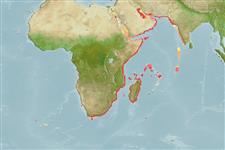>
Eupercaria/misc (Various families in series Eupercaria) >
Haemulidae (Grunts) > Haemulinae
Etymology: Pomadasys: Greek, poma, -atos = cover, operculum + Greek, dasys = with hair (Ref. 45335).
More on authors: Gilchrist & Thompson.
Environment: milieu / climate zone / depth range / distribution range
पारिस्थितिकी
समुद्री बेनथोपिलाजिक; गहराई सीमा ? - 30 m (Ref. 2799). Tropical
Western Indian Ocean: known originally from Beira, Mozambique to Knysna, South Africa; reported from the Red Sea and Gulf of Suez, but this might be a misidentification of Pomadasys stridens.
आकार / वज़न / Age
Maturity: Lm ? range ? - ? cm
Max length : 22.0 cm TL पुल्लिंग / अलिंग; (Ref. 2799)
पृष्ठीय रीढ़ (सम्पूर्ण) : 12; पृष्ठीय सौफट रेज़ (सम्पूर्ण) : 13 - 14; गुदा कांटा: 3; ऐनल सौफट रेज़: 6 - 7. Some specimens dark brown, with barely visible dark longitudinal stripes (Ref. 11228).
Found mainly around fringing reefs.
Life cycle and mating behavior
Maturities | पुनरुत्पत्ति | Spawnings | Egg(s) | Fecundities | लार्वा
Oviparous, distinct pairing during breeding (Ref. 205).
Smith, M.M. and R.J. McKay, 1986. Haemulidae. p. 564-571. In M.M. Smith and P.C. Heemstra (eds.) Smiths' sea fishes. Springer-Verlag, Berlin. (Ref. 2799)
IUCN Red List Status (Ref. 130435)
Threat to humans
Harmless
Human uses
साधन
Special reports
Download XML
इंटरनेट स्रोत
Estimates based on models
Preferred temperature (Ref.
123201): 21.3 - 28.6, mean 27 °C (based on 577 cells).
Phylogenetic diversity index (Ref.
82804): PD
50 = 0.5000 [Uniqueness, from 0.5 = low to 2.0 = high].
Bayesian length-weight: a=0.01995 (0.01061 - 0.03753), b=3.00 (2.84 - 3.16), in cm total length, based on LWR estimates for this species & Genus-body shape (Ref.
93245).
Trophic level (Ref.
69278): 3.4 ±0.5 se; based on size and trophs of closest relatives
Generation time: 3.7 ( na - na) years. Estimated as median ln(3)/K based on 1
growth studies.
लौटाव (Ref.
120179): माध्यम, न्यूनतम जनसंख्या दुगनी होने का समय 1.4 - 4.4 वर्ष। (K=0.30; tmax=4).
Fishing Vulnerability (Ref.
59153): Low to moderate vulnerability (33 of 100).
